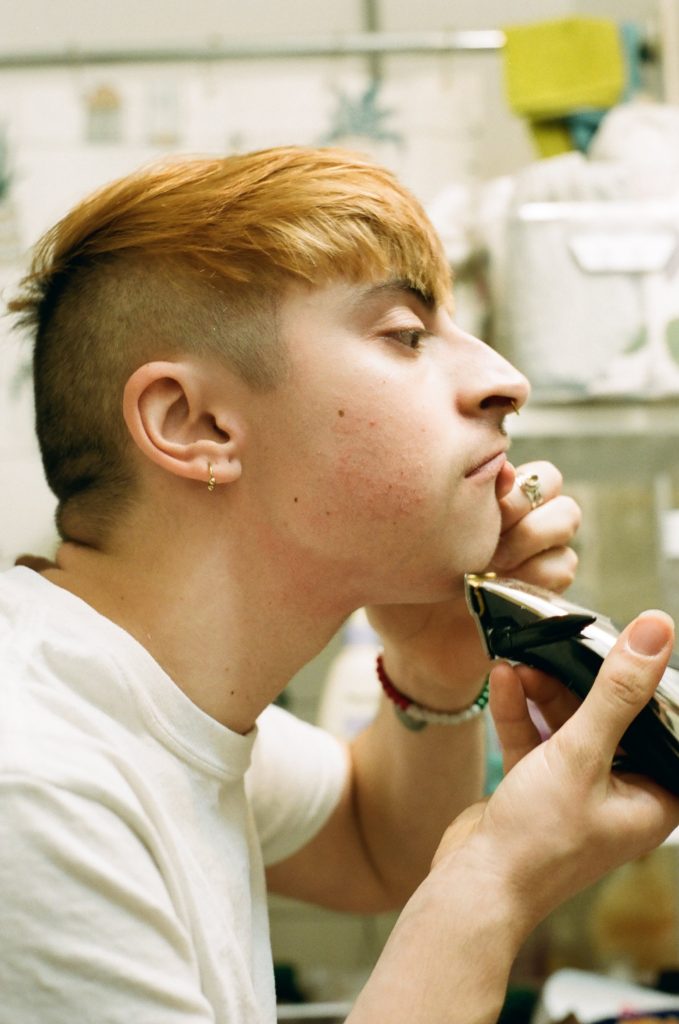by Shyam Patel
The corpses of academic trauma live in the bodies of people of colour. They exhaust — almost burning, rupturing — our existence limb by limb. As I trace — painfully extracting and exhuming — my own experiences and stories with/in academia, I am overcome by a sense of hardship and loss. Knowing that others like me, too, have similar travels with/in academia does not provide me with any form of solace. It only reminds me how treacherous and vile the culture of dominance, even with/in so called progressive and radical spaces, happens to be. Despite this, I still hold onto this notion of hope — perhaps even radical love — when I embark on dismantling and resisting colonial violence, finding ways of bringing my own voice from the margin to the center.
While reading Dr. Pat Palulis’ work, I reflect on the colonialist underpinnings of academia that often limit alternative ways of doing. She shares, “As professors colonized by the institution, we colonize our students who are eager to perform on their students what has been done to them” (Palulis 2009, 4). Adding to this, the realities of colonialist legacies with/in academia impact people of colour even more severely. Not only do we experience pain and trauma through the centralization of whiteness, we carry the burden of invisible work. The emotional labour of explaining the realities of racism, navigating whiteness, and negotiating our identities can be exhausting. This is even more harrowing when we explore the experiences and stories of women, queer, and trans people of colour. We see being white or whiteness as “normal” (Kendall 2002) and people of colour as oppositional to that supposed normalcy. Considering this, it is almost customary to fantasize about being white in academia, even temporarily (Bahia 2019) to feel a hardship lift itself; to be able to enter and navigate spaces without apologizing and being vigilant when speaking truth to power.
Drawing, then, on the work of Gayatri Spivak, the question of her essay title continues to be critical, and, dare I say, haunting: Can the Subaltern Speak? Spivak (1998) argues that the production of academic thinking is conceived and exported with the exploitative nature of Western tropes as the default. Within this, the term subaltern, as Spivak (1998) suggests, is not to be misconstrued. Spivak (1998) refers to the term as oppressed subjects — those who cannot speak and do not have histories with/in colonialist drippings. In academia, this is seen by the fact that research is oriented (Spivak 1998) and learning/teaching is still produced in the form of a banking model of education (Freire 2005). Furthermore, marginalized and stigmatized people are silenced with/in academia and our work is often only valued when it placates the narrative of whiteness. Thus, our ability to speak about our communities, experiences, and stories is confined by a white saviour complex — one that suffocates our narratives. Calling a resistance to this, Tuck (2009) draws attention to the problematization of “damaged-centered” research: “For many of us, the research on our communities has historically been damage centered, intent on portraying our neighbourhoods and tribes as defeated and broken” (412). There is a “historical exploitation and mistreatment of people and material” (Tuck 2009, 411), which I believe is another facet of the ongoing genocide towards Indigenous peoples. Suspended in this thought, I find myself awakening and rupturing, thinking about my own community/ies. All too often the perception of the third world, for example, is presented in the context of the “Other” and portrayed through a lens of poverty porn. Academia, under the guise of white privilege and white supremacy, continues to displace and disturb many of us. Perhaps the resonance of “unhomely” (Bhabha 1992) is one that will dissect us forever.
there is a light at the end of the tunnel. i run to reach it, but the further i go, the farther it seems to be. some days, i still see the light flickering. mostly, however, it seems to fade away and i wonder if the flicker of light was only a figment of my very own imagination.
Academia, however, is also a site of refuge for the wanderer. It can be a groundwork for healing and for (un)becoming. Palulis (2009) asks, “And how do we dwell with a simultaneous love and loathing for the premises?” (3). For me, dwelling and reflecting on my own experiences serves as a form of healing. Remarkably, Dr. Pat Palulis instilled in me this deep and enriching notion of the lived curriculum/a — one that centres and unfolds healing as a liberatory practice. She remarks, ““’[T]here is a gap that is still alive and this is where the work must be done. Not to close the gap but to work in the gap. To work in the space of the wound” (Palulis 2009, 4). I find myself swimming in the remnants of the wound (other parts of it still waiting to be retrieved) — its waxy residue plunging me into self-healing. In my two years in a Teacher Education program, I did just that. I sifted through the emotions and feelings of being a Brown man, with both privileged and marginalized intersections, and how the everyday experiences of racism impact me as a teacher and as a student. For once, I had somewhere to share; to volumize my body and identity into essays, journals, poems, reflections, and short stories. It did not come easily, but I found a reflective escape, to work on what Thich Nhat Hanh (2010) refers to as the inner, suffering child.
like limericks weaved on an open parchment, i find myself oozing in poetry — in this constant notion that haunts me and that has become a living memory of my life — that justice is a form of violence. in the realm of academia, it leaves traces of thoughts that follow me forever. i think about the time when a professor — in the opening slit of a margin (how ironically) — tells me that my writing is awkward. nonetheless, i come to resist — through small acts of protest — writing that speaks to a white narrative. i make indentations — dents that break into and penetrate a sentence — to allow room for a pause to linger — to let words seep into the reader’s mind. i refuse to let run-on-sentences evade me. sometimes, i enjoy the rambling of a sentence that tries to find a place of closure — not to end, but to find a home — a safekeeping. it is, in a way, similar to pressed pages being open. i feel liberated even when academia continues to be infiltrated by the perils of privileges and supremacies, looming at the corner of every page.
This notion of immersing myself with/in the compounds of my work — my artistry, my scholarship, my writing — ruptures me in a way that is almost exhilarating. Particularly, Aoki’s (1993) notion of the lived curriculum speaks profoundly to me. The lived curriculum/a or the curriculum-as-lived captures the diversities and experiences of our students. Settling in this notion, Aoki’s (1993) work has influenced me as I make sense of my location with/in academia, if such a place exists. For me, it is not simply a lived curriculum/a, it is a living curriculum/a, which requires oneself to perform constructively and continuously. Considering that Western tropes “racialize” the curriculum, lived experiences — the breathing out of suffocation — become ever so significant. As such, the personal narrative of the lived experience can poetically counter that racialization. As hooks (2003) writes, “I rely on the sharing of personal narratives to remind folks that we are all struggling to raise our consciousness and figure out the best action to take” (107).
encountering spaces that allow me to dissect my own livelihood, and, in many ways, resurrect my ancestry, allows me to find a place with/in academia. in the enclosed corners of a page, i am drawn into a vortex defined by a word limit…never ending, however, in its resonance. it is as if someone is listening to me, waiting on a story that slips from the ink of fingertips to (re)write the lines on a body. as if — almost gently — holding me, soothing the weeping soul that resides somewhere deep down with/in me. in that moment, i feel something has left its mark on me and i wonder if it will visit me soon again…
Similarly, there is value in lifting the text — its language and theory/ies — to speak to students. Discourse, in many ways, can be discursive and even harmful, especially if and when it is marred in colonialist thinking. At the same time, however, language and theorization can be “a location for healing” (hooks 1994, 59). As hooks poignantly says, “To heal the splitting of mind and body, we marginalized and oppressed people attempt to recover ourselves and our experiences in language. We seek to make a place for intimacy” (hooks 1994, 175). Borrowing further from feminist theorization, theory/ies can also be used to locate oneself (Lugones & Spelman, 1983); to find a place in all the disarray. Even though much of that language and theorization occurs in the English language, we must remind ourselves of the words of Adrienne Rich, “‘This is the oppressor’s language yet I need it to talk to you’” (hooks 1994, 167). I want to part from this realization, but it continues to consume me because I know the truth that simmers in those words. So, when I found language and theorization that spoke to me, particularly reading the works of critical race theorists and radical feminist thinkers, I was able to find the words to make sense of what I had been feeling — a feeling that had long overcome me. Echoing the words of Lugones & Spelman (1983), “The theory or account can be helpful if it enables one to see how parts of one’s life fit together, for example, to see connections among parts of one’s life one hasn’t seen before” (578).
when i read words that spoke to me, i did not only listen. i found myself in the leaflet with tears nourishing the veins. even when i found other words, sentences, paragraphs…i found myself returning to the ones that exhumed me. yet, sometimes i still feel that something is lost. that something, as i recover, is being taken away from me. i am suspended in this
In juxtaposition with these realities, there are the complexities that come with working against and with/in the lens of whiteness. Almost unknowingly, the disruptions, vis-à-vis a phenomenology of critical consciousness, we still (re)affirm critical race theories, intersectional feminist theories, queer and trans theorizations, and other critical pedagogies as a response — as an underlying cause and effect — to white academia. Furthermore, when we challenge whiteness, we are told that we always “make it about race” (Bahia 2019). As I landscape myself with/in the peripheries of academia, I wonder if such a remark will scar me, as well. It probably will and already has done so, but I will seep into the portrait, even if I have to clutch to the frame and make sure, in that “all about race” way, I dismantle and resist academia. In the words of Lorde (1984), “I have come to believe over and over again that what is most important to me must be spoken, made verbal and shared, even at the risk of having it bruised or misunderstood” (40).
Shyam
Shyam is a former member of the QPIRG-McGill Board of Directors and is currently a graduate student at the University of Ottawa, where he is pursuing a Master of Arts Education (Studies in Teaching and Learning). Prior to that, he was one of the co-organizers and founding members of the Teacher Candidates of Colour (TCC) Collective and he is now the organizer for the Education Graduate Students of Colour (EGSC). In his time, he enjoys reading novels, watching anime, and writing poetry
References
Aoki, Ted. “Legitimating the lived curriculum: Towards a curricular landscape of multiplicity.” Journal of Curriculum and Supervision 8, no. 3 (1993): 255-268.
Bahia, Jasmeet, “A graduate student of colour’s navigation through the ivory tower,” last modified July 2, 2019, https://www.universityaffairs.ca/opinion/in-my-opinion/a-graduate-student-of-colours-navigation-through-the-ivory-tower/.
Bhabha, Homi. “The world and the home.” Social Text, no. 31/32 (1992): 141-153.
Freire, Paulo. The pedagogy of oppressed. 30th anniversary edition. The Continuum New York: International Publishing Group, 2005.
hooks, bell. Teaching to transgress: Education as the practice of freedom. New York: Routledge, 1994.
hooks, bell. Teaching community: A pedagogy of hope. New York: Routledge, 2003.
Kendall, Frances. Understanding white privilege: Creating pathways to authentic relationships across race. New York: Routledge, 2006.
Lorde, Audre. Sister outsider: Essays and speeches. New York: Crossing Press, 1984.
Lugones, Maria, and Spelman, Elizabeth. “Have we got theory for you! Feminist theory, cultural imperialism and the demand for ‘the woman’s voice’” Women’s Studies Int. Forum 6, no. 6 (1983): 573-581.
Nhat Hanh, Thich. Reconciliation: Healing the inner child. California: Parallax Press, 2010.
Palulis, Patricia. “Geo-literacies in a strange land: Academic vagabonds provoking a pied.” Educational Insights 13 no. 4 (2009): 1-13.
Spivak, Gayatri. “Can the subaltern speak?” In Marxism and the Interpretation of Culture. Illinois: University of Illinois Press, 1998.
Tuck, Eve. “Suspending damage: A letter to communities.” Harvard Educational Review 79, no. 3 (2009): 409-427.















